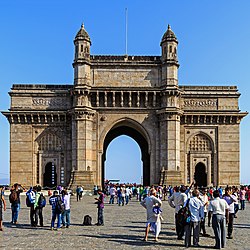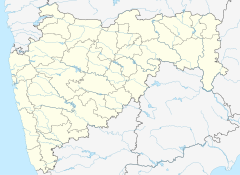
Back بوابة الهند (مومباي) Arabic Hindistan keçidi Azerbaijani Вароты Індыі (Мумбаі) Byelorussian गेटवे ऑफ़ इंडिया Bihari গেটওয়ে অব ইন্ডিয়া Bengali/Bangla Gateway of India CEB Brána Indie Czech Porth India (Mumbai) Welsh Gateway of India German Pordego de Barato (Mumbajo) Esperanto
| Gateway of India | |
|---|---|
 The Gateway of India | |
| Alternative names | Taj Mahal of Mumbai |
| General information | |
| Type | Triumphal arch |
| Architectural style | Architecture of Gujarat[A] |
| Location | Mumbai, India |
| Coordinates | 18°55′19″N 72°50′05″E / 18.9219°N 72.8346°E |
| Construction started | 31 March 1913 |
| Completed | 1924 |
| Inaugurated | 4 December 1924 |
| Cost | ₹21.13 lakhs |
| Owner | Archaeological Survey of India |
| Height | 26 m (85 ft) |
| Dimensions | |
| Diameter | 15 metres (49 feet) |
| Design and construction | |
| Architect(s) | George Wittet |
| Architecture firm | Gammon India |
| Renovating team | |
| Architect(s) | George Wittet |
| Website | |
| gatewayofindia.org | |
The Gateway of India is an arch-monument completed in 1924 on the waterfront of Mumbai (Bombay), India. It was erected to commemorate the landing of George V for his coronation as the Emperor of India in December 1911 at Strand Road near Wellington Fountain. He was the first British monarch to visit India.
The foundation stone was laid in March 1913 for a monument built in the Indo-Islamic style, inspired by elements of 16th-century Gujarati architecture. The final design of the monument by architect George Wittet was sanctioned only in 1914, and construction was completed in 1924. The structure is a memorial arch made of basalt, which is 26 metres (85 feet) high, with an architectural resemblance to a triumphial arch as well as Gujarati architecture of the time.
After its construction, the Gateway was used as a symbolic ceremonial entrance to India for important government personnel. The Gateway is also the monument from where the last British troops left in 1948, following Indian independence a year earlier. It is located on the waterfront at an angle, opposite the Taj Mahal Palace and Tower Hotel and overlooks the Arabian Sea. Today, the monument is synonymous with the city of Mumbai, and is amongst its prime tourist attractions. The Gateway is also a gathering spot for locals, street vendors, and photographers soliciting services. It holds significance for the local Jewish community as it has been the spot for Hanukkah celebrations, with the lighting of the menorah, since 2003. There are five jetties located at the Gateway, of which two are used for commercial ferry operations.
The Gateway was the site of a terror attack in August 2003, when there was a bomb blast in a taxi parked in front of it. Access to the gateway was restricted after people congregated at its premises following the 2008 Mumbai terror attacks, in which the Taj Hotel opposite the gateway and other locations in its vicinity were targeted.
In March 2019, the Maharashtra State Government proposed a four-step plan to develop the location for the convenience of tourists, following a direction issued by the State Governor in February 2019.
- ^ Bandyopadhyay, Ranjan 2008, p. 801.
Cite error: There are <ref group=upper-alpha> tags or {{efn-ua}} templates on this page, but the references will not show without a {{reflist|group=upper-alpha}} template or {{notelist-ua}} template (see the help page).


